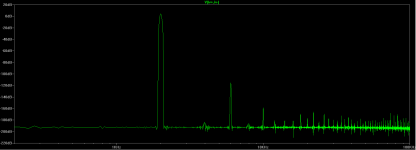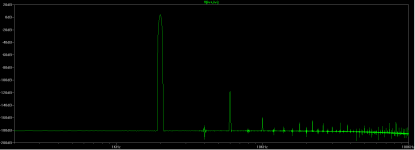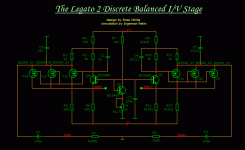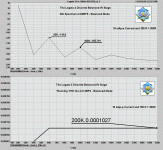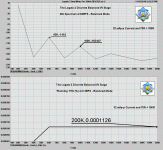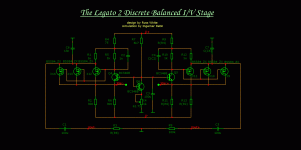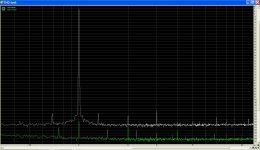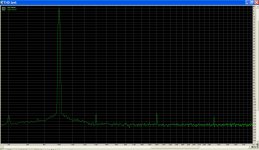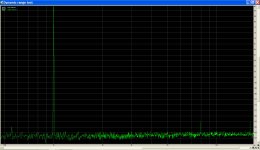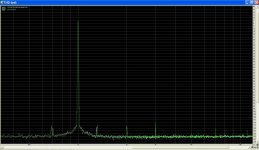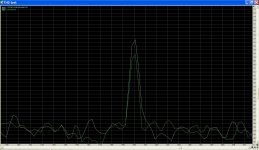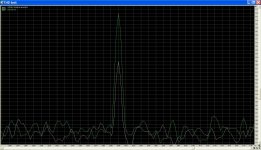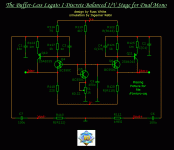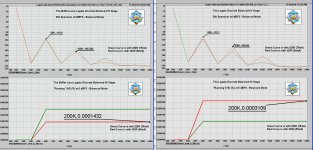Here is what my Legato II simulation shows:
The first is dual mono with 75R I/V and 150R(2 x 300 parallel) CCS and the common mode set to GND.
The second is stereo with those resistors doubled common mode still at GND.
The H3 is -123db for stereo and -121db for dual mono both THD numbers are so low as to be equivalent. The only real difference is that the dual mono will have lower output impedance and run nice and warm(but still ok). 🙂
Cheers!
Russ
The first is dual mono with 75R I/V and 150R(2 x 300 parallel) CCS and the common mode set to GND.
The second is stereo with those resistors doubled common mode still at GND.
The H3 is -123db for stereo and -121db for dual mono both THD numbers are so low as to be equivalent. The only real difference is that the dual mono will have lower output impedance and run nice and warm(but still ok). 🙂
Cheers!
Russ
Attachments
Also I simulated with the BSS84 only because it is a more realistic model than any of the BS250 models I have found. And it is actually slightly pessimistic as it has a higher RDS on. The two devices are very similar in all other respects.
Last edited:
Here is what my Legato II simulation shows:
The first is dual mono with 75R I/V and 150R(2 x 300 parallel) CCS and the common mode set to GND.
The second is stereo with those resistors doubled common mode still at GND.
The H3 is -123db for stereo and -121db for dual mono both THD numbers are so low as to be equivalent. The only real difference is that the dual mono will have lower output impedance and run nice and warm(but still ok). 🙂
Cheers!
Russ
Hi Russ
Thanks for showing Your simulations, H3 at -120 dB at circuit without NFB is absolutely amaizing....
Well it seems from symulations that, if I would like to do "ultra extreeme"... criticall listening on my Duall Mono 1 Legato setup, I should turn Volumite down like 3-4dB.....I thing that can be done with no problem.... it still will sound "to kill for".../if this could be the right expression/...😎.
Anyway I will also have to try Legato 2 as soon as it will be aviable..You are keeping us busy wit great new stuff.....
It seems that I need to ask for raise at my job....or save at chrismas presents, with my addiction to TP gear...🙂.
Rosendorfer
I also simulated the Legato 2,
and my result simulated in MicroCap10 for normal stereo balaqnced mode is as in the attachments.
Very similart to what Russ simulated in LT Spice. -120 dB at 3rd harmonics (60 kHz) at 0 dBFS.
/IR
and my result simulated in MicroCap10 for normal stereo balaqnced mode is as in the attachments.
Very similart to what Russ simulated in LT Spice. -120 dB at 3rd harmonics (60 kHz) at 0 dBFS.
/IR
Here is what my Legato II simulation shows:
The first is dual mono with 75R I/V and 150R(2 x 300 parallel) CCS and the common mode set to GND.
The second is stereo with those resistors doubled common mode still at GND.
The H3 is -123db for stereo and -121db for dual mono both THD numbers are so low as to be equivalent. The only real difference is that the dual mono will have lower output impedance and run nice and warm(but still ok). 🙂
Cheers!
Russ
Attachments
Here's my sim with dual ESS9018s feeding the Legato 2 with
75R and 150R.
-119 dB at 3rd harmonics (60 kHz) at 0 dBFS.
/IR
75R and 150R.
-119 dB at 3rd harmonics (60 kHz) at 0 dBFS.
/IR
Here is what my Legato II simulation shows:
The first is dual mono with 75R I/V and 150R(2 x 300 parallel) CCS and the common mode set to GND.
The second is stereo with those resistors doubled common mode still at GND.
The H3 is -123db for stereo and -121db for dual mono both THD numbers are so low as to be equivalent. The only real difference is that the dual mono will have lower output impedance and run nice and warm(but still ok). 🙂
Cheers!
Russ
Attachments
Hi Guys
It is not that I do not trust simulations ..well maybe just a little...
So having real measurements that confirm simulations have been really tempting... it took me some time but finally I have got something. Normally I would hesitate to post this kind of “measurements” but they "surprisingly" seems to be well correlated to simulations...
Please mind that as at the moment I'm talking about Legato1 ..
I hope some of You will find them interesting.
First few remarks:
All of measurements have been done with at 48kHz FS and RMAA6.2 demo version.
Using Laptop with WinXP ruining from batteries.
For demo version of RMAA 6.2 I could only use program default 1kHz THD signal.
Signal have been send to HiFace USB then with I2S to Buffalo and from Buffalo to Legato and depending on measurements in Dual Mono or Stereo set-up.
I did mount LM op-amp to have SE output from Legato.
First some system noise for reference:
Second Normal Stereo setup.
Third Dual Mono Setup
Fourth Both Stereo and Dual Mono at the same graph
And last close-up of 2-nd and 3 -rd harmonics.
CDN
Rosendorfer
It is not that I do not trust simulations ..well maybe just a little...
So having real measurements that confirm simulations have been really tempting... it took me some time but finally I have got something. Normally I would hesitate to post this kind of “measurements” but they "surprisingly" seems to be well correlated to simulations...
Please mind that as at the moment I'm talking about Legato1 ..
I hope some of You will find them interesting.
First few remarks:
All of measurements have been done with at 48kHz FS and RMAA6.2 demo version.
Using Laptop with WinXP ruining from batteries.
For demo version of RMAA 6.2 I could only use program default 1kHz THD signal.
Signal have been send to HiFace USB then with I2S to Buffalo and from Buffalo to Legato and depending on measurements in Dual Mono or Stereo set-up.
I did mount LM op-amp to have SE output from Legato.
First some system noise for reference:
Second Normal Stereo setup.
Third Dual Mono Setup
Fourth Both Stereo and Dual Mono at the same graph
And last close-up of 2-nd and 3 -rd harmonics.
CDN
Rosendorfer
Attachments
Hi
As for my measurements ... I hope they do load and can be seen...
Now there is a question If they are worth to be seen and how seriously we can treat them...
Well they have been made with 100USD EMU202 and we do look for sub -110dB changes....
So there are definitively not extremely accurate ..but... I did made much more of this measurements and they are repeatable with reasonable accuracy and they seems to be very well going on with IngermarR simulations...if not for the exact numbers, then for the system behaviour..
We can clearly see that with Duall mono setup third harmonics (3kHz) is definitely going up comparing to stereo setup ...exactly as in simulations....
This what can be seen and have been absent at simulations is strong presence of second harmonics...(2kHz)
....and now question is if this is effect of measurement setup or real life Legato is not perfectly symmetrical, well elements used to build it … And this is something simulations did not show us... Of cause Simulations did not include presence of LM opamp and this for sure have also strong influence on real life performance.
There is also important measurement issue that Dual Mono setup VS Stereo setup have +6dB output signal difference... well and at list few others things also.....
But as for proving the 3-rd harmonics increase with Dual Mono 1 Legato (!!!) setup this have done the job ….
Rosendorfer
As for my measurements ... I hope they do load and can be seen...
Now there is a question If they are worth to be seen and how seriously we can treat them...
Well they have been made with 100USD EMU202 and we do look for sub -110dB changes....
So there are definitively not extremely accurate ..but... I did made much more of this measurements and they are repeatable with reasonable accuracy and they seems to be very well going on with IngermarR simulations...if not for the exact numbers, then for the system behaviour..
We can clearly see that with Duall mono setup third harmonics (3kHz) is definitely going up comparing to stereo setup ...exactly as in simulations....
This what can be seen and have been absent at simulations is strong presence of second harmonics...(2kHz)
....and now question is if this is effect of measurement setup or real life Legato is not perfectly symmetrical, well elements used to build it … And this is something simulations did not show us... Of cause Simulations did not include presence of LM opamp and this for sure have also strong influence on real life performance.
There is also important measurement issue that Dual Mono setup VS Stereo setup have +6dB output signal difference... well and at list few others things also.....
But as for proving the 3-rd harmonics increase with Dual Mono 1 Legato (!!!) setup this have done the job ….
Rosendorfer
HI Rosendorfer, your measurements are very similar to mine using a sound card.
There will always be some small amount of of H2 distortion. If you are measuring the single ended output (after BAL/SE stage) this will very definitely be true.
If you can, please try measuring only the balanced outputs (you will have to look at the difference between + and -).
All in all those are very good measurements by anyone's standards. Thanks for posting! 🙂
The reason for the slight higher H3 dual mono is because the input impedance is not infinitely low, so you get a bit more modulation at the input at full scale. But at anything 6db down or more there will actually be advantages. 🙂
Good work!
There will always be some small amount of of H2 distortion. If you are measuring the single ended output (after BAL/SE stage) this will very definitely be true.
If you can, please try measuring only the balanced outputs (you will have to look at the difference between + and -).
All in all those are very good measurements by anyone's standards. Thanks for posting! 🙂
The reason for the slight higher H3 dual mono is because the input impedance is not infinitely low, so you get a bit more modulation at the input at full scale. But at anything 6db down or more there will actually be advantages. 🙂
Good work!
Tubed Buffalo II in dual mono?
Hi Russ,
I would like to change Buf I (lapizied) with exchanged 9008 chip to 9018 chip
into Dual mono Buf II. BUT I would like to make sure there is not a problem to
have tubes in power section and at the output with BUf II.
Is the Buf II board simmilar to Buf I board in terms of possible lampizition process?
Christ
Hi Russ,
I would like to change Buf I (lapizied) with exchanged 9008 chip to 9018 chip
into Dual mono Buf II. BUT I would like to make sure there is not a problem to
have tubes in power section and at the output with BUf II.
Is the Buf II board simmilar to Buf I board in terms of possible lampizition process?
Christ
Buffer Less Legato 1
Rosendorfer, here is a simulation of a balanced version of a buffer less L1 used by two ESS9018 DACs..
IV-resistor is 75 Ohms.
Dual ESS9018s feeding a Buffer less Legato 1.
Vout_balanced = 1,64 VACrms.
/IR
Rosendorfer, here is a simulation of a balanced version of a buffer less L1 used by two ESS9018 DACs..
IV-resistor is 75 Ohms.
Dual ESS9018s feeding a Buffer less Legato 1.
Vout_balanced = 1,64 VACrms.
/IR
Hi IngemarR
Could You make simulation for single ended output and if possible also output without the buffer, so we can see if this is making any difference.
60kHz 3-rd harmonics at -110dB is absolutely great resoult ...😎 but I'm bit puzzled why there is so big difference against normall stereo version @ -125,6dB, specially that it seems that this is not simply corelated with higher output level.
And any chances You could run Your simulation on "parallel mosfets" Legato 2 version....?
Best Regards
Rosendorfer
Attachments
In simulations with balanced amplifiers like this, even order harmonics will cancel out as the semiconductors used are exactly identical, which will never be the case in real life. Thus, even order harmonics will not cancel out as in simulations.
Good work!
/IR
Good work!
/IR
Hi
As for my measurements ... I hope they do load and can be seen...
Now there is a question If they are worth to be seen and how seriously we can treat them...
Well they have been made with 100USD EMU202 and we do look for sub -110dB changes....
So there are definitively not extremely accurate ..but... I did made much more of this measurements and they are repeatable with reasonable accuracy and they seems to be very well going on with IngermarR simulations...if not for the exact numbers, then for the system behaviour..
We can clearly see that with Duall mono setup third harmonics (3kHz) is definitely going up comparing to stereo setup ...exactly as in simulations....
This what can be seen and have been absent at simulations is strong presence of second harmonics...(2kHz)
....and now question is if this is effect of measurement setup or real life Legato is not perfectly symmetrical, well elements used to build it … And this is something simulations did not show us... Of cause Simulations did not include presence of LM opamp and this for sure have also strong influence on real life performance.
There is also important measurement issue that Dual Mono setup VS Stereo setup have +6dB output signal difference... well and at list few others things also.....
But as for proving the 3-rd harmonics increase with Dual Mono 1 Legato (!!!) setup this have done the job ….
Rosendorfer
Patalleling the Legato outputs
Hi Russ,
Did you try this ?
I think this would be great for dual-mono configuration.
Though I have not tried it you should be able to simply parallel the outputs of each legato as long as you don't use the buffer. No need to take the SE output.
If I have time I will give it a go.
Hi Russ,
Did you try this ?
I think this would be great for dual-mono configuration.
Russ,
may I ask why you chose to use several parallelled MOSFETs instead of a single medium sized BJT?
/IR
may I ask why you chose to use several parallelled MOSFETs instead of a single medium sized BJT?
/IR
Here is what my Legato II simulation shows:
The first is dual mono with 75R I/V and 150R(2 x 300 parallel) CCS and the common mode set to GND.
The second is stereo with those resistors doubled common mode still at GND.
The H3 is -123db for stereo and -121db for dual mono both THD numbers are so low as to be equivalent. The only real difference is that the dual mono will have lower output impedance and run nice and warm(but still ok). 🙂
Cheers!
Russ
Russ,
may I ask why you chose to use several parallelled MOSFETs instead of a single medium sized BJT?
/IR
The initial design did use all BJTs and small signal types are fine here.
They actually work quite well.
I prefer the MOSFETs right now simply because the CFP just worked a little better in practice with MOSFETs. I just sounds better to me, but don't ask me to explain why. 🙂 If initial measurements and simulations hold true, the change to FETs also produces lower distortion.
Cheers!
Russ
higher gm = lower distortion in this case
Actually the BJTs have the higher gm. 🙂 It's actually a bit deeper than that.
Rosendorfer, here is a simulation of a balanced version of a buffer less L1 used by two ESS9018 DACs..
IV-resistor is 75 Ohms.
Dual ESS9018s feeding a Buffer less Legato 1.
Vout_balanced = 1,64 VACrms.
/IR
Hi IngemarR
First thanks for Your simulations...
I have to say that thanks to Your and Russ input this simple thread did turn into "new dimention"...definetely much more interesting...
Legato now has many incarnations .....
But I have been looking at Your Buffer Less Legato 1 simulation and comparing to Legato1 with Buffer and THD for 3H - at 60kHz changed from -110dB to -116,9 dB .. and totall THD from 0,0003109 to 0,0001432 and this could explain why Russ is telling that when not needed it is better to go without Buffer....
But why this change is only at 50mA CCS standing current, R=330 RED Line?? and almoust nothing or even worst resoults for 75mA, R=220 Green Line..?? . Any possible explanation ... Or do I miss something..?
For both sim I/V R is 75Ohm...
Rosendorfer
Attachments
A BJT instead of a MOSFET could have 10X more Gm, so, Russ,
I am even more curious now. Capacitances are higher in MOSFETs as far as I know...hmmm....
It would be most apprecitaed if you could tell me what this "deeper" is?
/IR
I am even more curious now. Capacitances are higher in MOSFETs as far as I know...hmmm....
It would be most apprecitaed if you could tell me what this "deeper" is?
/IR
Actually the BJTs have the higher gm. 🙂 It's actually a bit deeper than that.
When I say that your measurements include BOTH distorsion from the ESS9018 (Buffalo 2) and the Legato 1, am I then correct?
Did you use the buffer on the Legato 1?
/IR
Did you use the buffer on the Legato 1?
/IR
Hi Guys
It is not that I do not trust simulations ..well maybe just a little...
Signal have been send to HiFace USB then with I2S to Buffalo and from Buffalo to Legato and depending on measurements in Dual Mono or Stereo set-up.
I did mount LM op-amp to have SE output from Legato.
First some system noise for reference:
Second Normal Stereo setup.
Third Dual Mono Setup
Fourth Both Stereo and Dual Mono at the same graph
And last close-up of 2-nd and 3 -rd harmonics.
CDN
Rosendorfer
- Status
- Not open for further replies.
- Home
- More Vendors...
- Twisted Pear
- Buffallo Dual Mono 1 Legato

